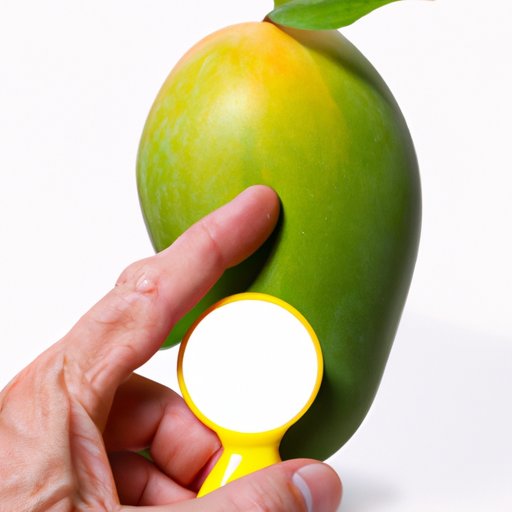Introduction
Mangos are a tropical fruit that can be enjoyed year-round! Mangoes are packed with vitamins, antioxidants and fiber and are a juicy and delicious addition to any snack or meal. However, the downfall of this juicy fruit is that it can be difficult to tell when it is ripe. This can be frustrating as an unripe mango can lack both flavor and texture, making it a not so enjoyable eating experience. So, how can you tell if a mango is ripe? In this article, we will explore several tips and tests to help make your mango selection a success.
Visual Cues
When looking to determine the ripeness of a mango, one of the first things to look for is visual cues. There are a few key indicators to look for:
Color
The color of a mango can vary depending on the variety. However, for most mangoes, the color of the skin will change from green to yellow or reddish-orange as it ripens. By looking for a change in skin color, you can generally tell if a mango is ripe.
Texture
The texture of the mango is another important visual cue. When a mango is ripe, it will feel slightly soft to the touch. A mango that is hard to the touch is usually not yet ripe.
Size
Size can also play a role in determining mango ripeness. As a mango ripens, it may become slightly larger and plumper.
Based on these visual cues, here are some tips for identifying a ripe mango:
- Choose a mango with skin that is primarily yellow or reddish-orange
- Look for a slightly soft texture when pressing lightly on the skin
- Choose a mango that is slightly plump
Softness Test
The softness test is another way to determine the ripeness of a mango. This test involves gently squeezing the fruit to check for a softness in the flesh. Here are the steps for performing the softness test:
- Hold the mango in your hand and gently squeeze with your fingers
- If the fruit gives slightly without feeling mushy, the mango is ripe
- If the mango feels firm to the touch, it is not yet ripe
Here are some tips for performing the softness test:
- Be gentle – don’t squeeze too hard or you risk damaging the fruit
- Practice with different mangoes to understand the right level of softness
Smell Test
Another way to determine the ripeness of a mango is through the smell test. A ripe mango will have a sweet, fruity aroma. Here are the steps for performing the smell test:
- Hold the mango close to your nose and sniff
- If you detect a sweet, fruity smell, the mango is ripe
- If there is no smell or a sour smell, the mango is not yet ripe
Here are some tips for performing the smell test:
- Get familiar with the smell of ripe mangoes so you can easily identify the fragrance
- Don’t be afraid to give the mango a good whiff. The stronger the smell, the better the chance it’s ripe and ready to eat
Shake Test
The shake test is another way to tell if a mango is ripe. By shaking the mango, you can feel if the flesh is separating from the pit, indicating a ripeness. Here are the steps for performing the shake test:
- Hold the mango gently in your hand and give it a shake
- If you feel the flesh moving away from the pit, the mango is ripe
- If there is little or no movement, the mango is not yet ripe
Here are some tips for performing the shake test:
- Be gentle with the mango as it bruises easily
- You can practice with different mangoes to develop a sense of the level of movement that indicates a ripe mango
Stem Test
The stem test is another way to determine if a mango is ripe. This test involves looking at the stem of the mango to gauge its ripeness. Here are the steps for performing the stem test:
- Locate the stem of the mango
- Gently pull on the stem. If it comes away easily, the mango is ripe.
- If the stem doesn’t give away easily, then the mango is not ripe yet.
Here are some tips for performing the stem test:
- If you’re shopping for mangoes, avoid picking ones with the stem removed as they will ripen poorly and won’t taste as good
- If you do find a mango with a missing stem, use this test to determine its ripeness
Experience Test
While the above tests can be effective in determining the ripeness of a mango, each individual may have their own preferences. Experience factors heavily into identifying the perfect mango, which means it is important to keep at it until you nail down your ideal ripeness. Here are some tips for using the above tests in conjunction with your experience:
- Practice – try using each test and document your findings for future reference
- Be patient – it may take some time to find the method that works best for you
- Experiment – try different varieties of mangos and see how the level of ripeness varies between them
Conclusion
We’ve explored several tests and tips for determining if a mango is ripe. From visual cues to softness, smell, shake and stem tests, there are many ways to tell if a mango is ripe. Remember that experience is also a key factor in identifying the perfect mango. With practice and patience, you’ll be able to easily choose ripe and delicious mangos every time.
